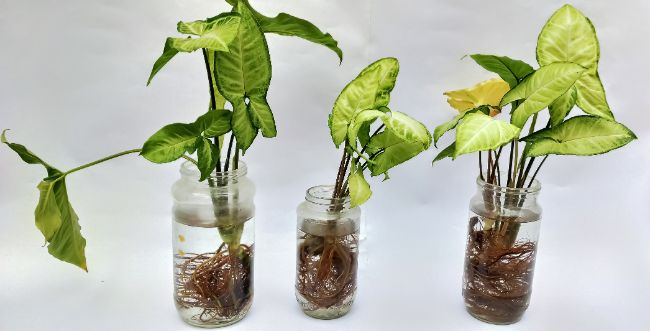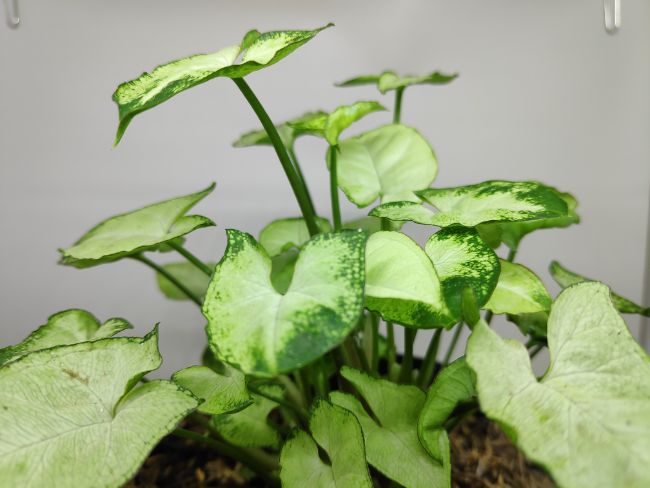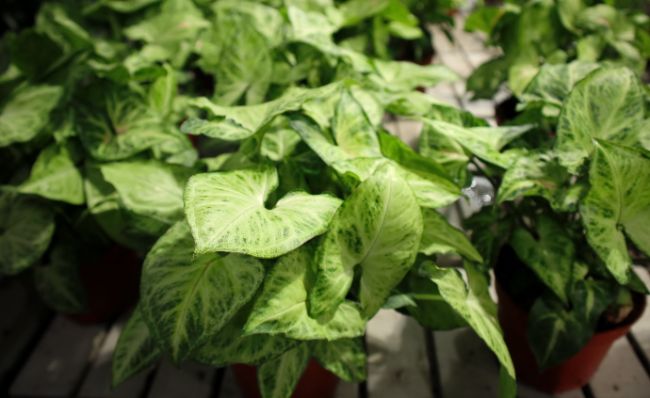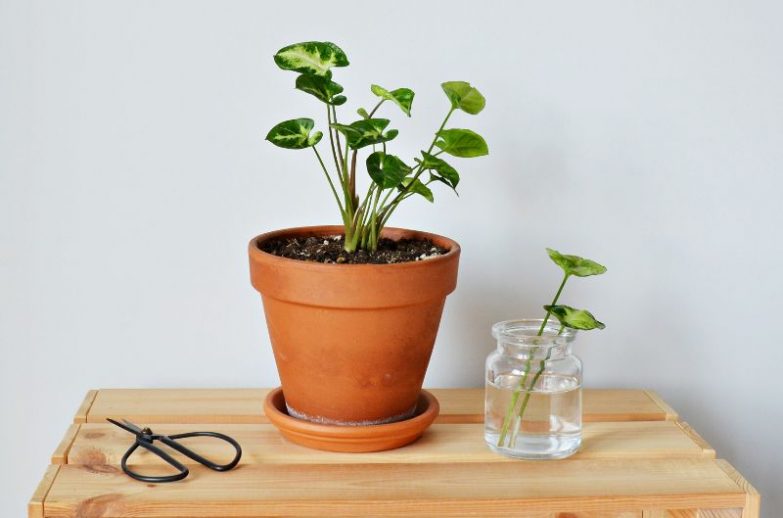The Arrowhead plant (Syngonium podophyllum) has been a popular houseplant for decades. Easy to care for, with beautiful and varied foliage, and best of all, you can propagate it with ease. In this article, we will look at Arrowhead Plant propagation to help you expand your collection of these wonderful houseplants.
An Arrowhead plant can be propagated from cuttings in either water or soil. Cut a 6-12 inch section of the stem just below a node. Plant in moist soil or put the stem directly in water. New roots will appear within 1-2 weeks and new leaves after about 4 weeks.
How To Propagate An Arrowhead Plant From Stem Cuttings
Stem cuttings are simply pieces of stem that are cut off from the parent plant and then used to grow a new plant. The essential thing is to make your cut below a node and to have at least one leaf already formed on the piece of stem that you remove from the original plant.
Personally, I prefer my stem cuttings to have two leaves as this allows for better photosynthesis as the cutting is developing.
A node is a joint in the stem which you will easily be able to recognize as it creates two bumps on opposite sides of the stem. Left to its own devices, the plant would eventually produce aerial roots from these nodes and they would aid the plant in climbing.
Make your cut just below this node as it is from the node that the first roots of your new plant will begin to appear in 1-2 weeks. It is important that you make you cut close to the node as any excess stem material is at risk of dieback and this could lead to disease.
Rooting Your Cutting In Water

As you are about to see, Arrowhead plant propagation is really easy and you have two options when it comes to rooting your cuttings.
Simply popping the cutting into a glass of water is probably the most common method. The node will need to always remain below the surface of the water with the leaves hanging on the lip of the glass or whatever container you choose to use.
Plant growers who take a lot of cuttings often use glass test tubes which they can stand in a rack so that they can root many cuttings at once.
You won’t need to go to this expense and even if you want to root several cuttings at once you can do so by just popping them into the same glass of water. After one to two weeks, you will notice that the nodes are starting to produce small white roots.
This is a sign that all is going to plan but it is not yet an indication that your cutting is ready to be potted up. It will take a few more weeks before the root system is strong enough to be planted into a pot.
Other than monitoring the root growth and making sure that the water level is always topped up, you won’t need to do much at this stage. Be aware, though, that as the plant develops it will consume water more quickly so keep an eye on that water level.
Rooting Your Cuttings In Soil
Some growers prefer to plant their cutting directly into soil. This method is equally effective and it comes down to personal choice as to which method you opt for. Those that plant directly into the pot point out that this eliminates any chance of shock as the plant is potted up.
It can help when planting cuttings into soil to use a rooting hormone to improve root development. Personally, I prefer being able to monitor root development as the roots grow in the water.
It is best to plant at least 4-6 cuttings into each pot, as this will give your Arrowhead plant a full and bushy growth habit and make for a really impressive plant.
It is ok to plant your cuttings directly into whatever pot you plan to keep them in. Try to keep the soil lightly moist during the first few weeks of growth. This will prevent your cuttings from wilting and help them establish faster.
It also helps to keep humidity high, and place the pot in bright, indirect light. Excessive direct sunlight will cause your cuttings to wilt, while low light will negatively impact their growth.

When To Propagate An Arrowhead Plant
It is best to propagate an Arrowhead plant in spring or summer, as the plant will be growing strongly at this time and the cuttings will establish themselves quickly.
However, as they are so resilient, Arrowhead plant propagation can be done at most times of the year with a reasonable success rate.
Why Take Cuttings?
The most obvious reason to take cuttings simply because you want to have more plants but there are other good reasons to propagate an Arrowhead plant.
A Leggy Plant
These plants originate across a large swathe of central and south America where they grow in rain forests. Their natural method of growth is to scramble up trees using their aerial roots as support.
When grown in the home this opportunity is no longer available and so the plant can easily become leggy as is sends out shoots in search of something to climb.
This can leave the plant looking somewhat bald and straggly and taking cuttings will not only allow for fresh production but will also serve to prune the parent plant into a more eye-pleasing shape.
A Sick Plant
Another reason to take cuttings could be that the parent plant is showing some signs of disease. In that case, it would be prudent to take cuttings from healthy areas of the plant so that you don’t risk finding yourself with no plant at all.
Maintenance Of Plant Characteristics
Finally, there are many varieties and cultivars of this plant. They offer a wide spectrum of variegated colors ranging from white through to pink or red. If the variegation starts to revert to the more common green, then it may be possible to take cuttings from an area of the plant where the desired color is still strong and repeat it in the new plants.
Arrowhead Plant Propagation Aftercare
These plants like to grow in free-draining soil and you will need to plant them into one right from the start. You will need to keep the new plants moist but not too wet.
After the first 3-4 weeks, you can cut back on watering a little, allowing the top inch of soil to dry before watering, so you don’t overwater and kill your plants with kindness. Read this article for more tips on when to water your houseplants.
Allow the soil to drain after watering and don’t leave the plant standing in a saucer filled with water. You will discover that this plant is very forgiving so don’t be put off if this sounds complicated.
One other watering tip is to use water that is at room temperature thus preventing the risk of shocking the plant with a sudden cold flush to the roots.
As they get older, these plants become increasingly tolerant of a range of light levels, but try to aim for bright light with minimal direct sunlight to give your cuttings the best chance.
An east-facing windowsill is usually a good place to get young plants established. If the leaves become dry and bleached then they are receiving too much light and you will need to move them to somewhere with lower light exposure.

Forming Your New Plant
There are several forms that this plant can take but they are governed by the gardener. In its natural environment, the plant likes to scramble upwards. You can facilitate this by providing a moss pole to climb. A plant will eventually reach six feet in height or more if well supported in this way.
Not everyone wants or has room for, a plant that is climbing and many houseplant owners prefer their plants to grow in a dense mass in a pot or bowl.
Here you are training the plant to do something that it would not normally do and so a bit more effort is needed. You will have to keep pinching out the tendrils that the plant sends out. This will encourage more growth from the base and develop more of a rounded shape. You will need to start this training quite soon after the plant starts to take root.
You can augment the dense appearance of a plant by plugging stem cuttings directly back into the pot or bowl that the parent plant is growing in and this will add to the dense appearance.
The final option is to grow the plant in a trailing manner. This is very simple because as the plant sends out tendrils they will naturally trail if they don’t find something to climb. I have seen this method put to good effect when plants were allowed to trail from a bannister down towards a room below.
Maintenance
These underrated plants can put on a fine foliage display and require very little effort on the part of the gardener. Once they start to become established, they should be fed with a general-purpose house plant fertilizer once a fortnight throughout the growing season.
Once they become more dormant during the cooler months you can stop feeding them until the following season. They prefer temperatures of around 60°F but even in this respect, tend to be very tolerant. Like most house plants, they enjoy a bit of humidity but an occasional squirt of water from a squeegee will keep them perfectly happy.
Last Word
Arrowhead plant propagation is simple and rewarding, allowing you to easily produce more plants, or thicken up an existing plant by adding more cuttings to the pot. You may like to read my Arrowhead plant care guide for more tips on keeping your Arrowhead plants thriving and looking their best.

